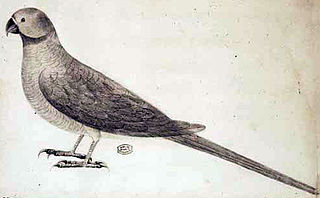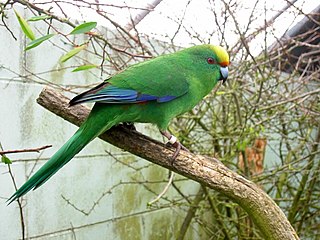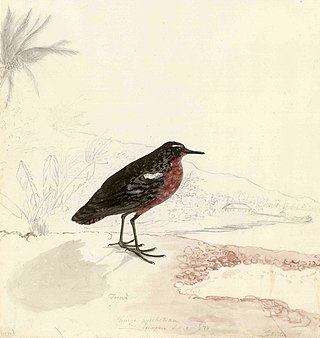
Newton's parakeet, also known as the Rodrigues parakeet or Rodrigues ring-necked parakeet, is an extinct species of parrot that was endemic to the Mascarene island of Rodrigues in the western Indian Ocean. Several of its features diverged from related species, indicating long-term isolation on Rodrigues and subsequent adaptation. The rose-ringed parakeet of the same genus is a close relative and probable ancestor. Newton's parakeet may itself have been ancestral to the endemic parakeets of nearby Mauritius and Réunion.

Cyanoramphus is a genus of parakeets native to New Zealand and islands of the southern Pacific Ocean. The New Zealand species are often called kākāriki. They are small to medium-sized parakeets with long tails and predominantly green plumage. Most species are forest dwellers, although several of the subantarctic species live in open grassland. The genus formerly had a widely disjunct distribution: while most of the genus ranged from New Caledonia to Macquarie Island, two species were found in the Society Islands, 4,100 km (2,500 mi) away from the rest. Although the islands between these two areas have yielded many bird fossils, undescribed extinct Cyanoramphus have not yet been found on any of them.

The white swamphen, also known as the Lord Howe swamphen, Lord Howe gallinule or white gallinule, is an extinct species of rail which lived on Lord Howe Island, east of Australia. It was first encountered when the crews of British ships visited the island between 1788 and 1790, and all contemporary accounts and illustrations were produced during this time. Today, two skins exist: the holotype in the Natural History Museum of Vienna, and another in Liverpool's World Museum. Although historical confusion has existed about the provenance of the specimens and the classification and anatomy of the bird, it is now thought to have been a distinct species endemic to Lord Howe Island and most similar to the Australasian swamphen. Subfossil bones have also been discovered since.

Cyanoramphus malherbi is a small parrot endemic to New Zealand, where it is known as the orange-fronted parakeet or orange-fronted kākāriki. In the rest of the world it is called Malherbe's parakeet, as when it was recognised as a species, the name "orange-fronted parakeet" was already used for Eupsittula canicularis, a Central American species. Restricted to a few valleys in the South Island and four offshore islands, its population declined to around 200 in the 1990s, and it is considered critically endangered.

The Tuamotu sandpiper is an endangered member of the large wader family Scolopacidae, that is endemic to the Tuamotu Islands in French Polynesia. It is sometimes placed in the monotypic genus Aechmorhynchus. A native name, apparently in the Tuamotuan language, is kivi-kivi.

The Tahiti Sandpiper or Tahitian Sandpiper is an extinct member of the large wader family Scolopacidae that was endemic to Tahiti in French Polynesia until its extinction sometime before 1819.

The Seychelles parakeet or Seychelles Island parrot is an extinct species of parrot that was endemic to the Seychelles in the Indian Ocean. It was scientifically named Palaeornis wardi by the British ornithologist Edward Newton in 1867, and the specific name honours the British civil commissioner Swinburne Ward who procured the specimens that formed the basis for the description. It was found on the islands of Mahé, Silhouette, and possibly Praslin. Ten skin specimens exist today, but no skeletons. Though the species was later moved to the genus Psittacula, genetic studies have led some researchers to suggest it should belong in a reinstated Palaeornis along with the closely related Alexandrine parakeet (P. eupatria) of Asia.

The hoopoe starling, also known as the Réunion starling or Bourbon crested starling, is a species of starling that lived on the Mascarene island of Réunion and became extinct in the 1850s. Its closest relatives were the also-extinct Rodrigues starling and Mauritius starling from nearby islands, and the three apparently originated in south-east Asia. The bird was first mentioned during the 17th century and was long thought to be related to the hoopoe, from which its name is derived. Some affinities have been proposed, but it was confirmed as a starling in a DNA study.

The red-crowned parakeet, also known as red-fronted parakeet and by its Māori name of kākāriki, is a small parrot from New Zealand. It is characterised by its bright green plumage and the red pattern on its head. This versatile bird can feed on a variety food items and can be found in many habitat types. It used to be classified as near threatened as invasive predators had pushed it out of its historical range but it is now at least concern. This species used to occupy the entire island, but is now confined to only a few areas on the mainland and some offshore islands.

The extinct black-fronted parakeet or Tahiti parakeet was endemic to the Pacific island of Tahiti. Its native name was simply ’ā’ā ("parrot") according to Latham (1790) though White (1887) gives "aa-maha".

The Mascarene parrot or mascarin is an extinct species of parrot that was endemic to the Mascarene island of Réunion in the western Indian Ocean. The taxonomic relationships of this species have been subject to debate; it has historically been grouped with either the Psittaculini parrots or the vasa parrots, with the latest genetic study favouring the former group.

The Tahiti rail, Tahitian red-billed rail, or Pacific red-billed rail is an extinct species of rail that lived on Tahiti. It was first recorded during James Cook's second voyage around the world (1772–1775), on which it was illustrated by Georg Forster and described by Johann Reinhold Forster. No specimens have been preserved. As well as the documentation by the Forsters, there have been claims that the bird also existed on the nearby island of Mehetia. The Tahiti rail appears to have been closely related to, and perhaps derived from, the buff-banded rail, and has also been historically confused with the Tongan subspecies of that bird.

The ground parrot of Australia is one of only four ground-dwelling parrots in the world, the others being its closest relatives, the extremely rare night parrot, the somewhat closely related Antipodes parakeet, and the unrelated highly endangered kakapo from New Zealand.

The Grand Cayman thrush is an extinct bird from the thrush family (Turdidae). It was endemic to the island of Grand Cayman in the Caribbean.
The Tasman starling was described in 1836 by John Gould as a species which occurred on both Norfolk Island and Lord Howe Island. In 1928 Australian ornithologist Gregory Mathews recognized that the plumage of the race from Lord Howe Island was much browner and more greyish than the plumage of the Norfolk Island race and split the species into two forms, the Norfolk starling, and the Lord Howe starling. Both subspecies are now extinct, thus so the species.

The Chatham parakeet, also known as Forbes' parakeet, is a rare parakeet endemic to the Chatham Islands group, New Zealand. This parakeet is one of New Zealand's rarest birds and is classified as Vulnerable on the IUCN Red List, as a result of a range of threats to the species survival, including habitat loss, predation, and hybridization. A number of conservation methods have been employed to assist the recovery of this species, and currently the population trend is considered stable.

The Norfolk parakeet, also called Tasman parakeet, Norfolk Island green parrot or Norfolk Island red-crowned parakeet, is a species of parrot in the family Psittaculidae. It is endemic to Norfolk Island.

The limestone leaf warbler is a species of warbler in the family Phylloscopidae. When this species was first seen, beginning in 1994, it was mistaken for the similar sulphur-breasted warbler. It is smaller than the sulphur-breasted warbler, and has more rounded wings. The plumage is almost identical, with comparisons showing only a slightly colder yellow below and a greyer tinge above. Although smaller, the bill is proportionally larger than that of the sulphur-breasted warbler. Accurate measurements are not available; the holotype has a wing length of 5.2 cm (2.0 in); the paratype a tail length of 3.7 cm (1.5 in) and a bill length of 1.39 cm (0.55 in). The species is known to occur in northern Vietnam and Laos, and potentially also occurs in southern China as well. The species name, calciatilis, means "dwelling on limestone", which along with its common name is a reference to its natural habitat, which is broadleaved evergreen and semi-evergreen forest growing around limestone karst mountains. The bare-faced bulbul, described in 2009, was found in the karst of the same region.

The Raiatea starling, formerly known as the bay thrush, bay starling, or the mysterious bird of Ulieta, is an extinct bird species of uncertain taxonomic relationships that once lived on the island of Raiatea, the second largest of the Society Islands in French Polynesia.

The Society Islands tropical moist forests is a tropical and subtropical moist broadleaf forests ecoregion in the Society Islands of French Polynesia.




















